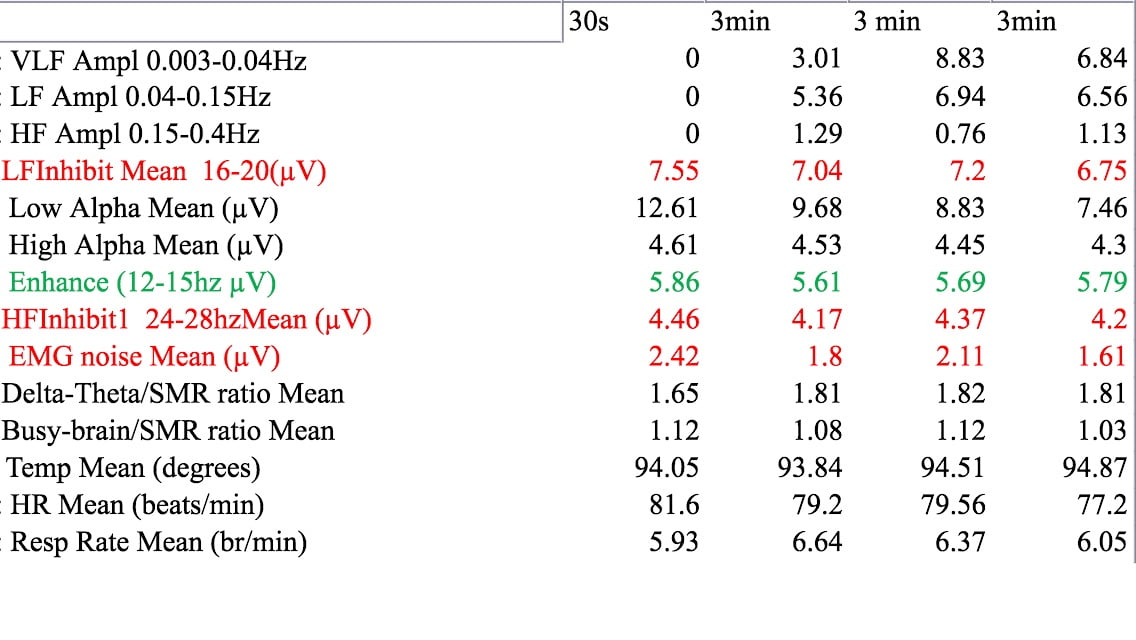Last year, after eye surgery, my iPhone display looked enormous. These days, it looks teeny weeny. Amazing how adaptation changes perception. I no longer get dizzy moving my eyes across a wide screen. My brain is used to the sharper-looking text and more depth in the screen colours. My panoramic vision isn’t solid yet, but I’m used to seeing my iPhone display left to right, top to bottom, in one go. No more bits missing like before the eye surgery.
I still very occasionally get double vision, partly because my brain is still fighting to return to my pre-surgery default and discard the new binocular information. But brain biofeedback at PZ (top middle back) to inhibit 16-20 Hz, the thinking brainwaves, seems to be helping me win that fight.
(They call the excessive 16-20 Hz “high-beta spindling.”)
Slowly, panoramic vision outside on the streets and in parks is solidifying – one marker of that is being able to cross side streets without having to consciously narrate every step like I have had to since the eye surgery. Now after brain training I can see the traffic on both peripheries of my vision and process it in real time.
My proprioception is improving again; I’m able to distinguish myself in space with full up-down side-to-side awareness, which means I’m not returning to my old default with bits missing in that awareness. (I’ve just realized I don’t keep bumping into door jambs like I used to!) The first week of November I was able to discern the bottom step of the TTC stairs from the landing peripherally (and for the second week through my feet too) while looking ahead at a fixed point and walking down slowly and carefully.
This is huge!
Being able to go down the visually inaccessible steps on the TTC is a lot safer when one can see the low contrasts and feel the differences. It’s a lot of work and fatiguing trying to navigate the bloody TTC when not able-bodied, able-eyed, able-brained. Have I mentioned I hate it?!
Let’s think about more positive things — like my heart! This week was another in a series of OM Effing G!! Did you seeeee that?!!! As I mentioned before, the goal back in 2012 was to raise my HRV (the measure of how well my heart syncs with breathing) from the basement to a modest 10 and to lower my heart rate from freaky 130 to double digits. Also, to get rid of the scary-ass rises to 170 and drops to 30-50 beats per minute. It’s been a slow slog. Low-intensity light therapy (concussion protocol) where the lights are over my cerebellum definitely began to move things along in the right direction. But now–
My low frequency HRV got to 8.57!!!!!

8.57 uV for low frequency heart rate variability (HRV) during HRV training — basically deep breathing — is stupendous enough but to get 8.24 during gamma brainwave training and again have LF higher than sympathetic nervous system activity (VLF) is WOW!!

LF wasn’t as high during PZ training to inhibit 16-20 but look at that — 5.36 during the first neurofeedback screen! Sweet.
Reducing my 16-20 Hz brainwaves is not only cementing my improved vision, it’s also been working on my trauma-related round-and-round thoughts that whirl up grief, distress, hurt into an ever-intensifying tornado. I didn’t mention the emotion effects to anyone because we were focused on my vision and I wasn’t sure if it was for real, but recently I’ve become sure. My thoughts drop out of the whirling and into clear thinking. Clear thinking is the antithesis of trauma and flashbacks. Clear thinking settles emotions. Relief. Even if it’s only for a few hours or days.
But how is reducing high-beta spindling helping my HRV too?
I came across an article that said the cerebellum is involved in emotional control. We already know it’s tied into the heart via control of the autonomic nervous system. Soooo, using logic — if the cerebellum is involved in emotions and so is the area around PZ, then they must network. And then flow from the emotional control part of the cerebellum into the heart control. Brain injury and healing of injury is like exploring the brain.



